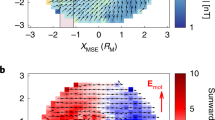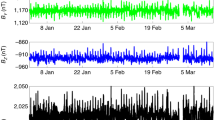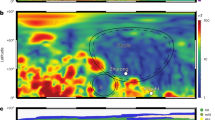Abstract
Little is known about the internal properties of Callisto—the outermost of Jupiter's four large galilean moons—other than the average density (about 1.8gem-3). The recent unexpected discovery1–4 that Ganymede, and perhaps Io, has an internally generated magnetic field, combined with gravity results5,6 suggesting that both Ganymede and Io are internally differentiated with metallic cores and rocky mantles, has heightened anticipation of the results obtained by the Galileo spacecraft in its recent fly-by of Callisto. Here we report that the spacecraft, passing the moon at a distance of only ∼1,100 km from the surface, detected only a small enhancement of the field strength (∼7nT), which maybe related to changes in the jovian plasma environment caused by Callisto7. Callisto does not have an internally generated magnetic field.
This is a preview of subscription content, access via your institution
Access options
Subscribe to this journal
Receive 51 print issues and online access
$199.00 per year
only $3.90 per issue
Buy this article
- Purchase on Springer Link
- Instant access to full article PDF
Prices may be subject to local taxes which are calculated during checkout
Similar content being viewed by others
References
Kivelson, M. G. et al. A magnetic signature near Io: Initial report from the Galileo magnetometer. Science 273, 337–340 (1996).
Kivelson, M. G. et al. Io's interaction with the plasma torus: Galileo magnetometer report. Science 274, 396–398 (1996).
Kivelson, M. G. et al. Discovery of Ganymede's magnetic field by the Galileo spacecraft. Nature 384, 537–541 (1996).
Gurnett, D. A., Kurth, W. S., Roux, A., Bolton, S. J. & Kennel, C. F. Evidence for a magnetosphere at Ganymede from plasma-wave observations by the Galileo spacecraft. Nature 384, 535–537 (1996).
Anderson, J. D., Laux, E. L., Sjorgren, W. L., Schubert, G. & Moore, W. B. Gravitational constraints on the internal structure of Ganymede. Nature 384, 541–543 (1996).
Schubert, G., Zhang, K., Kivelson, M. G. & Anderson, J. D. The magnetic field and internal structure of Ganymede. Nature 384, 544–545 (1996).
Gurnett, D. A., Kurth, W. S., Roux, A. & Bolton, S. J. Absence of a magnetic-field signature in plasma-wave observations at Callisto. Nature 387, 261–262 (1997).
Kivelson, M. G., Khurana, K. K., Means, J. D., Russell, C. T. & Snare, R. C. The Galileo magnetic field investigation. Space Sci. Rev 60, 357–383 (1992).
Belcher, J. W. in The Physics of the Jovian Magnetosphere 68–105 (Cambridge Univ. Press, 1983).
Dessler, A. J. in The Physics of the Jovian Magnetosphere 498–504 (Cambridge Univ. Press, 1983).
Vasyliunas, V. M. in The Physics of the Jovian Magnetosphere 395–453 (Cambridge Univ. Press, 1983).
Barbosa, D. D. On the injection and scattering of protons in Jupiter's magnetosphere. J. Geophys. Res. 86, 8981–8990 (1981).
Frank, L. A. et al. Plasma observations at Io with the Galileo spacecraft. Science 274, 394–395 (1996).
Neubauer, F. M. Nonlinear standing Alfvén wave current system at Io: Theory. J. Geophys. Res. 85, 1171 (1980).
Whang, Y. C. Interaction of a magnetized solar wind with the moon. Phys. Fluids 11, 969–975 (1968).
Colburn, D. S. et al. Diamagnetic solar wind cavity discovered behind the moon. Science 158, 1040–1042 (1967).
Owen, C. J. et al. The lunar wake at 6.8 RL: WIND magnetic field observations. Geophys. Res. Lett. 23, 1263–1266 (1996).
Anderson, J. D., Lau, E. L., Sjogren, W. L., Schubert, G. & Moore, W. B. Gravitational evidence for an undifferentiated Callisto. Nature 387, 264–266 (1997).
Author information
Authors and Affiliations
Rights and permissions
About this article
Cite this article
Khurana, K., Kivelson, M., Russell, C. et al. Absence of an internal magnetic field at Callisto. Nature 387, 262–264 (1997). https://doi.org/10.1038/387262a0
Received:
Accepted:
Issue Date:
DOI: https://doi.org/10.1038/387262a0
This article is cited by
-
Large Ocean Worlds with High-Pressure Ices
Space Science Reviews (2020)
-
Induced magnetic fields as evidence for subsurface oceans in Europa and Callisto
Nature (1998)
-
Gravitational evidence for an undifferentiated Callisto
Nature (1997)
-
Galileo at Jupiter — meetings with remarkable moons
Nature (1997)
-
Absence of a magnetic-field signature in plasma-wave observations at Callisto
Nature (1997)
Comments
By submitting a comment you agree to abide by our Terms and Community Guidelines. If you find something abusive or that does not comply with our terms or guidelines please flag it as inappropriate.



